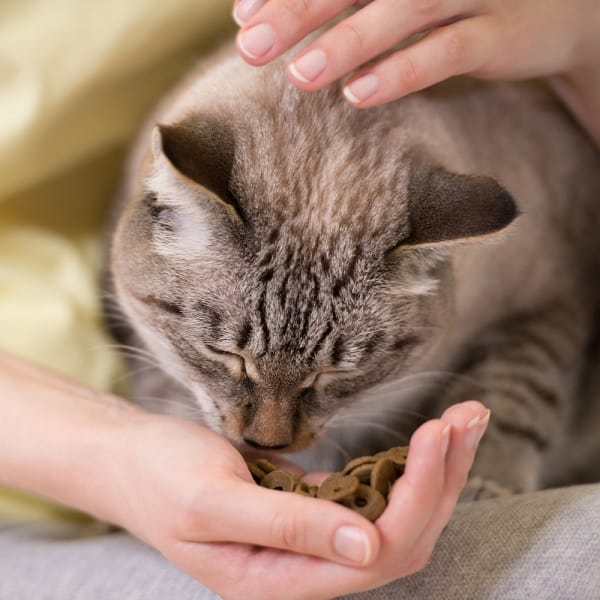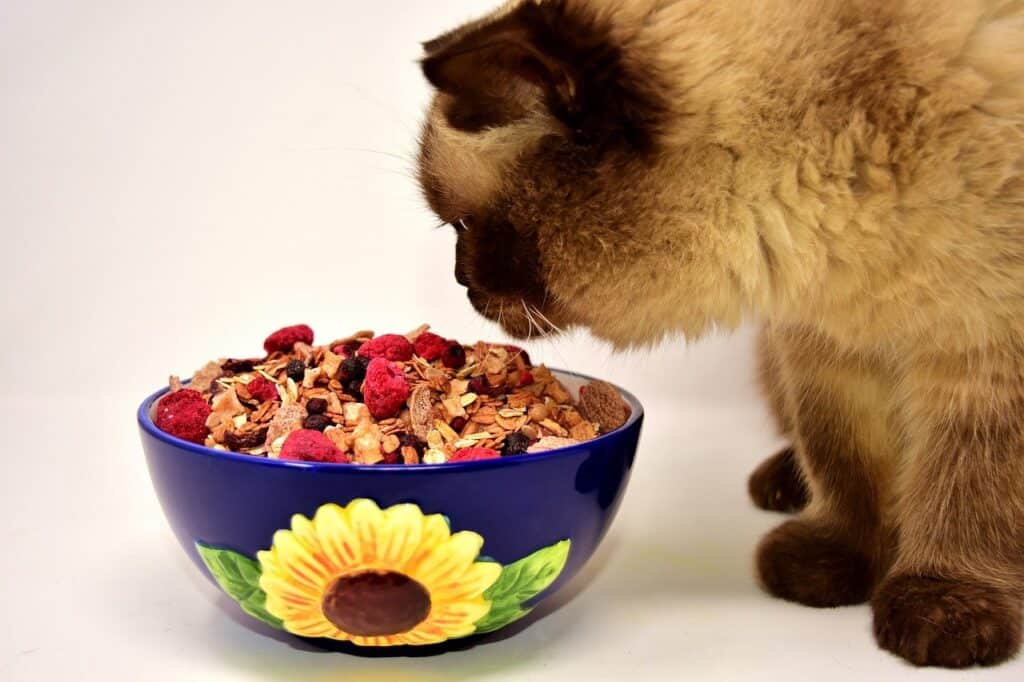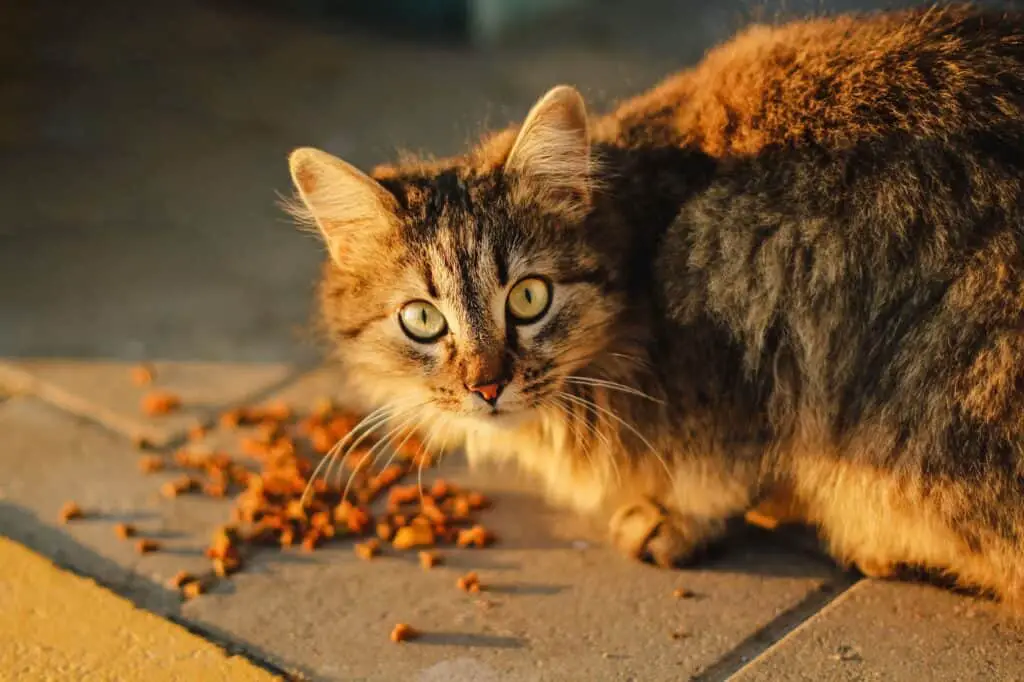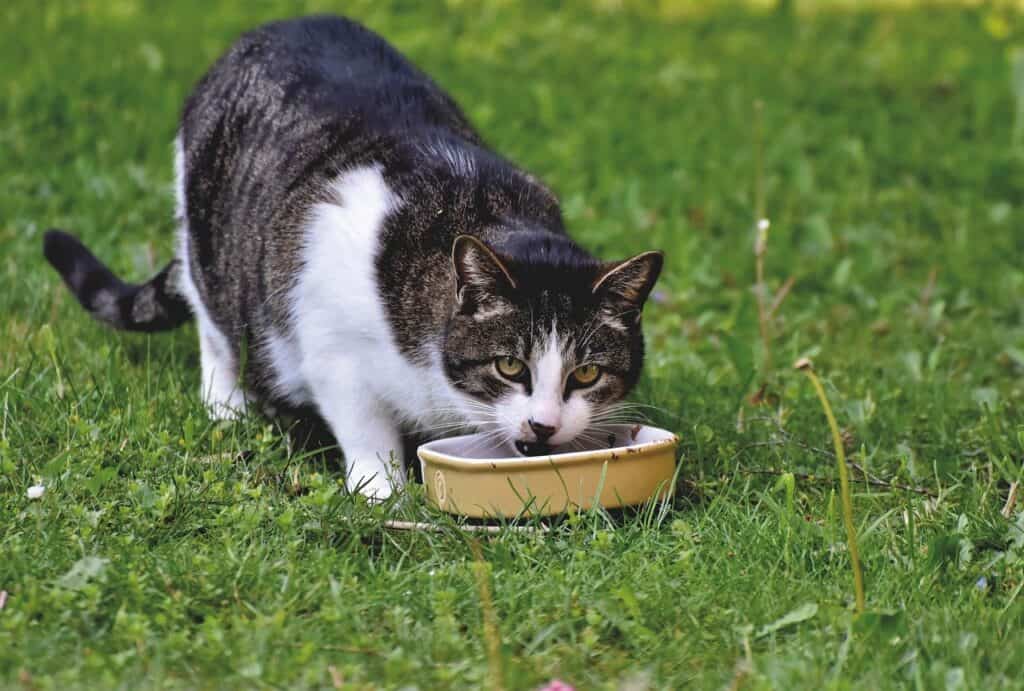What we should feed our cats is among the most heavily debated topics on the internet. Should cats eat primarily wet food, or is dry cat food better for them? Or would it be best to feed them a mix of both?
As a cat owner, these are probably questions you have asked yourself, and you may not be sure about what’s actually best. Researching the topic online will result in ambiguous answers and advice.
So, we decided to ask several veterinarians what they think is cats should eat to stay healthy.
According to most vets, cats should eat both wet and dry food. Both types of food belong in a balanced cat diet because they both have specific benefits to your cat’s health. Wet food improves the feline’s water intake while dry food improves their dental health.
Which is better, wet or dry cat food?
Both wet and dry food have benefits and drawbacks, and those may mean that you, or your cat, prefer one over the other. For example, if your cat has bad teeth, dry food may not be the best choice, and some cats are picky and prefer one over the other.
Ultimately there are several factors to take into account when deciding on your cat’s diet. As a rule of thumb, though, the vets we spoke with always advise to feed a mix of wet and dry food.
Both choices have specific benefits that will help your cat live a long and healthy life. When mixing wet food with dry kibble, you will give your cat the best of both worlds.
To help you make an unbiased choice between both and help you decide what’s best for your cat, we’ll have a look at the differences between wet and dry cat food.
The moisture levels in wet food are beneficial to cats
The main difference between wet and dry food is that wet food contains a lot more water when compared to dry food. In nature, cats are not very good drinkers, and they get the majority of the moisture they need from their food.
If your cat eats primarily dry food, she may not get enough moisture, leading to unary tract problems or kidney failure. Always make sure there is a water bowl nearby, so your cat has the opportunity to supplement its water intake.
Dry food and wet food have different nutritional value
Dry food usually contains more carbohydrates compared to wet food, which is richer in proteins. A feline diet that consists primarily of carbs is prone to lead to weight issues or obesity, which is a common problem for felines.
The exact composition of the food and the amount of carbohydrates, fat, and protein will differ from brand to brand or the type of food you have. Some specific diet kibble may have reduced carbohydrate content.
Dry food for convenience – wet food for freshness
There’s no doubt about it; dry food wins when it comes to convenience. First of all, it’s easier and faster to prepare. Other than that, it has a longer shelflife, and you can use it in automatic feeders and dispensers.
Wet food needs a bit more attention than dry kibble. Your cat will not eat it if it’s not relatively fresh. In case you’re planning to be out for a day or two, wet food cannot be prepared in advance.
Wet cat food is suitable for consumption up to 4 hours after serving. Beyond that, it will start to degrade rapidly. Cats are very particular about their food, and when they smell that food is not fresh, they will not consume it. When kept refrigerated, wet food can be stored for about 24-48 hours.

Dry food is more economical
Generally, dry cat food is cheaper compared to wet food. Although there are significant differences in price based on the quality, brand, and manufacturing process, the average cost of a dry kibble bag is between $1 and $4 (USD) per pound.
The average cost per serving is between $1 and $5 (USD) for wet cat food. Again, it depends on several things like ingredients, brand, nutritional/dietary ingredients, etcetera. Depending on your cat’s size and its calorie intake, she might need more than one serving per day.
Wet food resembles a cat’s natural diet
It’s evident that in the wild, a cat won’t find a bowl of kibble. A cat’s natural diet consists of small prey, which can be anything from a rodent to a lizard or a bird or even small insects. These prey are rich in proteins and gives a cat all the nutrients it needs to live a healthy life.
However, that doesn’t mean that dry food is bad, just because it’s not something that cats would eat in nature. Dry cat food in itself has some clear benefits to a cat’s health as well; read on.
Dry food is beneficial for your cat’s dental health
Cats commonly suffer from bad dental health, and it’s not unusual that your cat loses teeth due to decay when reaching old age.
To slow the decay of your cat’s teeth, dry food can help. Because of the dry and hard texture, it aids in removing plaque and dirt from your cat’s teeth.
On the other hand, just giving your cat some kibble will not take care of all its dental hygiene needs. We advise looking after your cat’s dental health by brushing its teeth regularly or using dental care products specifically for cats.
Studies show that cats who eat primarily wet food have more tartar on their teeth, leading to tooth decay.
For weight loss, wet food is better
If your cat is overweight and you’re trying to make your cat lose weight. It’s best to stay away from dry food. The high protein and low carb in wet food will keep your cat feeling full for much longer and prevent it from continuously feeding during the day.
It’s difficult for cats to lose weight when they’re on a primarily dry food diet. Due to the absence of moisture in the kibble, it’s easy for them to overeat since it will make them feel less full.
For easy eating, wet food is the best
Especially when your cat gets older and its teeth are not that strong anymore, dry food may not even be an option, and you’re better off feeding wet food exclusively.
The same goes for kittens who are transitioning from mother’s milk to regular food. For them, it’s best to start with a wet food diet. Due to the wetness, it will be easier for their stomachs to adjust to the change.
In case you’re transitioning from dry to wet food, take it slow and don’t suddenly change from one day to the next. Cat stomachs are very sensitive, and a significant change all of a sudden may upset their insides and cause vomiting or diarrhea.
If your cat is new to wet food, you may need to experiment a bit and find a brand or a taste that works for your cat.
A diet of primarily dry food may cause health issues
Cats who mainly eat dry food may develop certain health issues faster than cats on a mixed or wet food diet.
One of the most common problems is urinary tract issues. Especially in males, due to the longer urinary canal, there is a greater risk of blockage caused by minerals present in dry cat food. This could lead to difficulty for your cat to relieve himself and could damage the kidneys.
Another common issue is that overconsumption of dry cat food leads to obesity due to the higher amount of carbohydrates in dry food. If your cat lives an active life, it will probably be OK, but less active cats may put on extra weight. Obesity in cats can cause a range of health risks, such as diabetes.
What if my cat only wants to eat wet food?
Your cat will choose its favorite diet. Knowing that they are very picky eaters, it’s no use trying to force a cat to eat something it doesn’t want or like.
Especially cats who go outside will find alternatives elsewhere if the house’s menu is not to their liking.
Although we think both wet and dry food have a place in a cat’s menu, and it’s best to provide both, if your cat prefers wet food, that is perfectly fine. Indeed, this is better than the other way around.
Serving suggestion
If you have the ‘pate’ variant, slice it up in small pieces so your cat can easily pick it up. For cat food that comes out of the fridge, it’s good to heat it in the microwave for about 3 to 5 seconds. This will enhance the taste and aroma. Be careful, though, not to overheat the food to protect your cat from burns.
Can you mix wet and dry cat food?
Some cats like it when wet and dry food is mixed together. This is perfectly fine and a good option for cats that tend to eat a lot. Mixing dry with wet food will make your cat full quicker. It’s best to add the dry component just before serving to prevent it from getting mushy.

Things to consider
Your cat’s preference
Your cat may prefer one food type over the other, and even within both types, they may have their preferences for specific ingredients or brands. If your cat is a picky eater, it’s a good idea to experiment with different menus. Once you’ve found something that your cat likes, it’s best to stick with that brand but still ensuring a varied diet.
When mixing food types, keep an eye on your cat’s calorie intake
While over-feeding is never a good idea, it’s a good idea to keep an eye on your cat’s calorie intake when feeding kibble. Due to the high nutritional value of dry food, a handful of kibble can add a considerable amount of calories to your cat’s diet.
How many calories does your cat need?
The below table gives an overview of the recommended daily calorie intake for cats. Keep in mind that these are average guidelines. Your cat might need more or less depending on their situation.
For example, cats who often go outside into the cold need more calories than indoor cats.
| Daily recommended calorie intake for cats | 5 lbs | 10 lbs | 15 lbs | 20 lbs |
|---|---|---|---|---|
| Kitten | 200 kcal | 400 kcal | 600 kcal | 800 kcal |
| Lean Cat | 170 kcal | 280 kcal | 360 kcal | 440 kcal |
| Overweight Cat | 180 kcal | 240 kcal | 280 kcal | 310 kcal |
| Pregnant Cat | 336 kcal | 603 kcal | 850 kcal | 1090 kcal |
Preservatives and additives
You might want to keep an eye on the preservatives and additives that are present in cat food. Especially dry food will contain preservatives to extend the shelf-life of the food.
Some brands choose natural preservatives such as Vitamine E, C, or rosemary. Although natural, they can’t work wonders, and artificial preservatives are better at extending shelf-life.
Not all preservatives are by definition bad, but there are a few to avoid; ethoxyquin, butylated hydroxyanisole (BHA), and butylated hydroxytoluene (BHT).
Wet cat food is preserved by default due to the canning process, and therefore, it needs fewer chemical additives, both for preservation and for taste enhancement.
One additive to avoid at all costs is BPA (Bisphenol A), which is often present in the plastic lining of the cans. BPA is toxic and is already banned in plastic baby bottles but still allowed in packaging for pet food.
AAFCO Approval
Basic minimum nutritional requirements for cats have been established by the Association of American Feed Control Officials (AAFCO). This is important because all pet foods that carry an “AAFCO statement“ or “AAFCO-approved nutritional guarantee” are considered to be nutritionally complete and well-balanced diets for your cat.
Ingredient List
It’s important to read the label on the back of the package to ensure that the main ingredients, which will be listed first, consisting of meat and meat by-products. This is because cats are carnivores and require a high-protein diet that supplies the appropriate amount of essential amino acids and fatty acids.
Final thoughts
Overall we would choose to feed our cat a mix of wet and dry food because both have their (health) benefits. However, If your cat clearly prefers wet food, then don’t force dry food.
If you have to choose between both, always choose wet food over kibble. The benefits of wet food outweigh those of dry food. Wet food should be the main component of your cat’s diet, and kibble or dry snacks can supplement it.
At the end of the day, we humans are mere servants of our cats, and your royal highness will let you know if she disapproves of your menu choices.
The bottom line is that you should feed your cat what they want to eat. For the picky eaters, it can take some time and effort to figure out what they like.
We hope that this article helped distinguish between the pros and cons of wet and dry cat food, and it will help you decide on your cat’s ideal diet.
Feel free to share your thoughts and experience with our readers in the comments below.
Frequently Asked Questions
Do cats need wet food every day?
Although consistency in a cat’s diet is important, it’s no problem to incidentally feed only dry food on some days. On the other hand, if your cat is used to having wet food, it may not be something they easily accept.
What is the healthiest wet cat food?
Both wet and dry food have their pros and cons, but overall wet food has the best nutritional value. The fact that it contains a lot of moisture prevents cats from getting dehydrated. Wet food is also the most similar to their natural diet. Wet food should be the primary component of a cat diet where kibble can be a supplement.
Can I mix dry and wet cat food?
You can feed your cat a mixed diet of wet and dry food. It’s important to keep an eye on your cat’s calorie intake. Due to the high carbohydrate content in dry food, your cat may be at risk of over-eating and obesity as a result.
Can cats get sick from old wet food?
There is a health risk for cats when eating food that not fresh or past its use-by date. However, cats have a perfect sense of smell, and they will undoubtedly sense when the food is not suitable for their consumption. It is, therefore, rare that cats will eat expired food.
Why does my cat not finish her food?
Generally speaking, cats may not finish their food for the same reasons as humans. Either they are full, they need a more diverse menu, or they are uncomfortable while eating. Cats have small stomachs and eat small amounts throughout the day. Also, they don’t need to consume a lot of calories to stay healthy.





